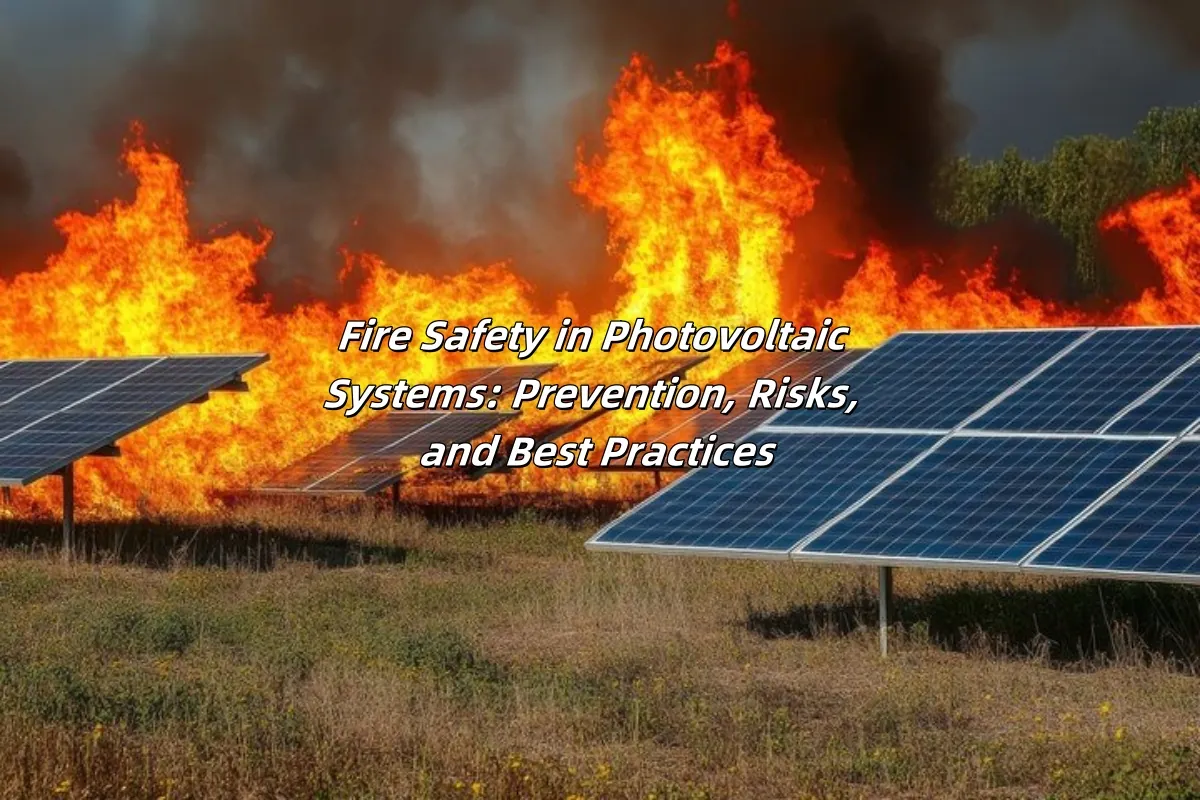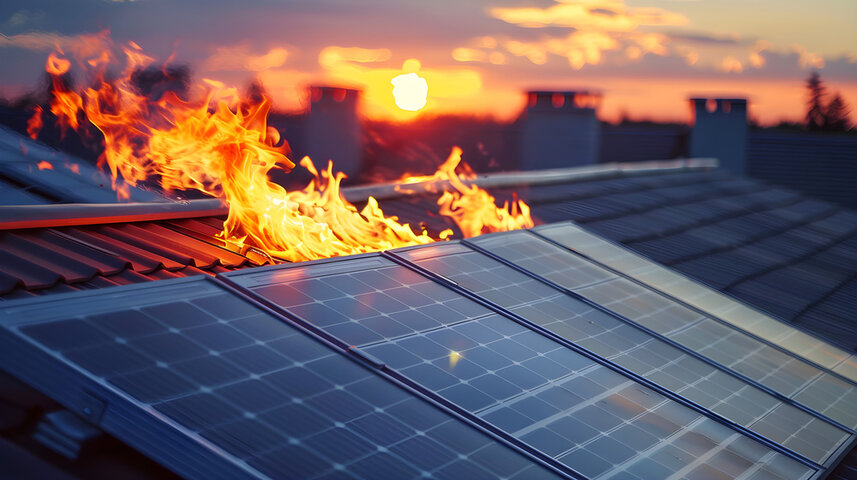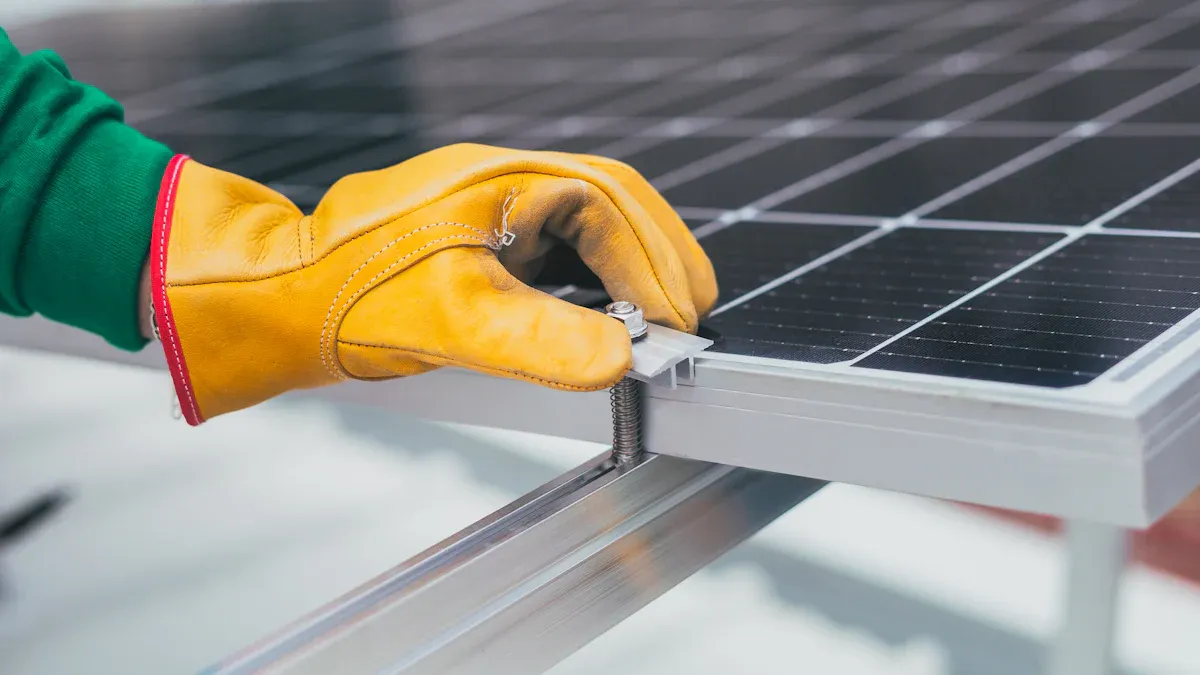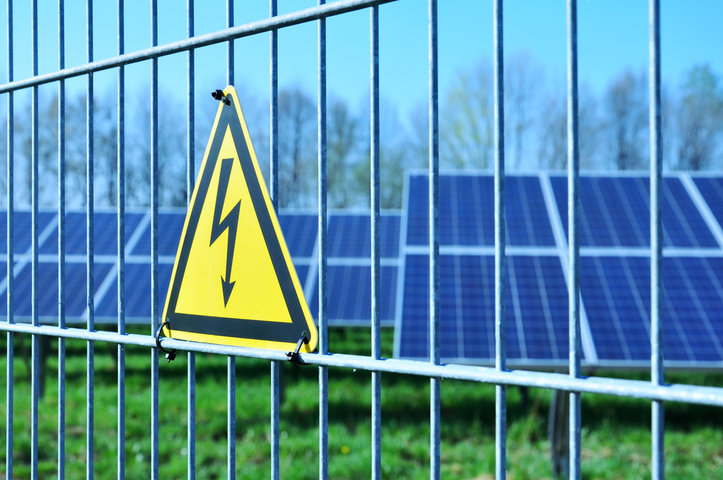+86 17727759177
inbox@terli.net
- All
- Product Name
- Product Keyword
- Product Model
- Product Summary
- Product Description
- Multi Field Search
Views: 0 Author: Site Editor Publish Time: 2025-09-25 Origin: Site
You can lower fire pv risks in photovoltaic systems with good fire prevention and regular safety checks. Fire safety is important for your property and for emergency workers. Ask yourself: Do your solar systems have certified equipment? When did you last check your wiring? Studies show that fire dangers go up with PV systems. Look at the table below to see how these risks affect safety for everyone:
| Evidence Description | Impact on Fire Risk |
|---|---|
| PV systems can make old fire risks worse and make fires stronger. | More risk for property owners and emergency workers. |
| PV systems make direct current, which can cause muscle problems if shocked. | Higher chance of injury during firefighting. |
| PV systems made fires worse in some investigations. | Makes firefighting harder. |
| Smoke from burning PV parts can mess up smoke and air systems. | Can help fire spread in buildings. |
| Firefighters feel more scared and unsure with PV system fires. | More danger during firefighting. |
Always pay attention to fire safety and make it a top goal.

Check your photovoltaic system often to find problems early. Try to check it at least once a year. Check after storms too.
Use equipment that is certified. Follow safety rules when you install it. This lowers fire risks and follows the law.
Use shutdown devices for each module. These devices lower voltage fast in emergencies. This helps firefighters stay safe.
Keep the space around solar panels clean. Remove trash and things that can burn. This stops fire from spreading.
Teach your family about fire safety. Show them what to do if there is a fire. Make sure everyone knows how to act in an emergency.
Photovoltaic systems have many good points. But you must know the main fire risks before you install or work on them. Most fires start on the DC side. The voltage there can be between 600 and 1000 volts. High voltage makes fire and shock more likely.
The DC side always has electricity moving through it. This part is where most fire risks happen. If you do not install or take care of the system right, you can face many dangers.
Bad installation can start fires. Using the wrong equipment or having loose wires can make hot spots. These hot spots can burn things nearby.
Live DC cables can shock you, especially in a fire. Firefighters and people who own the building must be careful near these cables.
Solar panels add weight to your roof. This can make the roof weaker in a fire. The roof might fall down faster.
You should also learn about DC arc faults. These happen when electricity jumps over a gap. This jump makes a spark or arc. The arc gets very hot and can start a fire. Look at the table below to see how different problems can cause DC arc faults and fires:
| Cause of DC Arc Faults | Contribution to Fire Incidents |
|---|---|
| Breakdown of conductor continuity | Loose joints, rust, and bad connections can make arcs. These arcs get very hot and can burn things. |
| Breakdown of insulation systems | Bad insulation, animal damage, and water can cause arcs. These arcs stay hot and can start fires. |
| Series and parallel arcs | Both types can happen if things go wrong. They can cause big fire risks in photovoltaic systems. |
DC arc faults have caused more than 400 building fires in Australia. These fires hurt people and damage buildings. You can lower these risks by using certified equipment and installing things the right way.
Electrical shock is another big risk in fire pv events. The DC circuits in photovoltaic systems can still have power even if you turn off the grid. This means you or firefighters can still get shocked during a fire.
The voltage in these circuits is very important. Safety rules say the voltage must drop to 80 volts or less in 30 seconds for modules and parts inside the array. For wires outside the array, the voltage must drop to 30 volts or less in 30 seconds. If this does not happen, the shock risk stays high.
| Voltage Level | Requirement |
|---|---|
| 80 V | Must drop to this level in 30 seconds for modules and exposed parts inside the PV array boundary |
| 30 V | Must drop to this level in 30 seconds for wires outside the array boundary |
You should know that touching live parts can hurt firefighters. Water used to put out the fire can make shock risk worse. Solar panels keep making power if they get sunlight, even if you turn off the main switch. Broken panels and wires make things even more risky.
Tip: Always use module-level shutdown devices. These devices help lower the voltage fast and make the system safer for everyone in an emergency.
Firefighters must stay away from solar arrays. Normal safety steps may not work because DC power acts differently than AC power. Wearing the right personal protective equipment (PPE) is very important. You should always follow safety rules and check your system often to lower the risks.

If the wiring in photovoltaic systems is not done right, it can be very dangerous. Faulty wiring is one of the main reasons fires start. Problems like rusty cables, loose wires, and bad grounding happen a lot. These problems can make electricity jump and cause sparks and heat. After a while, this heat can start a fire near the wires.
| Evidence Type | Description |
|---|---|
| Annual Fire Incident Frequency | 0.289 fires per MW |
| Major Cause of Fires | Electrical arcing due to compromised wiring |
| Percentage of Fires from Unknown Sources | 33% |
| Prime Contributor to Fires | Connector (17% of PV-related fires) |
You should look for common wiring problems. These include open circuits, short circuits, and ground faults. Each problem can stop the flow of electricity or make it go the wrong way.
Open circuit: A break in the wire stops the electricity.
Short circuit: Too much electricity moves between wires that touch by mistake.
Ground fault: Electricity finds a wrong path to the ground.
Electrical problems can cause fires by making sparks, arcs, and hot equipment.
You need to check your system often. Regular checks help you find loose or broken wires before they cause a fire.
Bad installation makes fire pv events more likely. Every part of your system should be put in by trained workers. Problems from bad installation include loose wires, messy cables, and broken parts. Old back sheets and inverter problems can also cause trouble.
Electrical faults
Overheating
Bad installation or poor maintenance
Loose wires
Broken cables
Not enough airflow
Not following safety rules
You should also think about where you put the panels. If panels are too close together, heat can get trapped. Not doing regular checks makes things worse. Hot spots and problems from installation can make fires start.
Things outside, like hail or dry plants, can also start fires. You must keep the area around your panels clean and check for damage after storms.

You help lower fire risk when you install a photovoltaic system. Good installation keeps your property safe from fire. Always pick certified equipment and follow international standards. These standards tell you to use safe materials and good methods.
| Standard | Focus Area |
|---|---|
| IFC Fire Code | Rules for PV power systems, like installation and care |
| NFPA 855 | Ways to lower fire risks in solar panels and energy storage |
| NEC Code | Rules for safe electrical design and solar PV installation |
| IBC Codes | Rules for design, materials, and building rooftop solar |
| ASCE/SEI 7-16 | Rules for how much weight solar projects can handle |
| UL Testing | Tests to make sure PV modules are safe before use |
Follow these steps to make installation safer:
1. Pick solar panels that meet the right standards.
2. Talk to a trusted solar installer.
3. Buy panels from trusted companies.
Certified equipment meets tough safety rules. These parts go through hard tests for fire safety and strength. Solar panels must have fire resistance ratings. Class A panels give the best fire protection. They use materials that stop flames and slow fire spread. Class B and Class C panels protect less.
| Classification Type | Fire Safety Index (FSI) | Description |
|---|---|---|
| Class A | FSI <= 25 | Best fire protection |
| Class B | FSI 26 to 75 | Medium fire protection |
| Class C | FSI 76 to 200 | Least fire protection |
Check that your installer uses Class A panels on rooftops. This helps lower fire risks and keeps you safer. Make sure your system has module-level shutdown devices. These devices lower voltage fast in emergencies and help firefighters.
Tip: Ask your installer to show proof of certification and fire resistance before they start. This helps you avoid fire safety problems later.
You must keep your photovoltaic system in good shape for fire safety. Regular care helps you find problems early and stop fire pv events. Check your system often and keep notes on all checks.
Look at important parts for loose spots, bent parts, dust, or rust. Use infrared tools to find hot spots.
Clean off dry leaves, dust, and bird nests from the roof. Make sure inverters have good airflow.
Write down all inspection work. Use online tools to watch equipment status.
Regular checks are needed to stop fires. Pay extra attention to rooftop systems because they have more risk. Checking often helps you find fire dangers and fix them before they get worse.
Note: Make a plan for checks. Look at your system at least once a year. Check more often if you have storms or lots of debris.
Keep the area around your panels clean. Take away things that can burn, like dry plants or trash. Good airflow around your system lowers fire risk. If you see damage after a storm, fix it fast.
Update your maintenance notes. Digital records help you see changes and spot problems. Early warning systems can tell you about trouble before a fire starts.
Your actions keep your system safe. Stay alert and take care of your system. Fire safety works best when you mix good installation with regular care.

If you think there is a fire in your photovoltaic system, act quickly and stay safe. Always believe your solar panels have power, even at night or when it is cloudy. Do not use strong water streams to put out a fire pv event. If you need water, use a fog spray instead. Keep a Class C fire extinguisher close for electrical fires.
Keep paths around your panels clear. This helps emergency workers get to the area fast. Put smoke detectors near indoor parts of your solar setup and test them every month. Make sure your family knows how to leave the house and who to call if there is an emergency. Give a drawing of your solar system to the local fire department. Show where the disconnect switches and module-level shutdown devices are.
Treat all panels and wires as having power.
Do not touch broken equipment.
Keep paths open for emergency crews.
Test smoke detectors every month.
Tell your fire department about your solar system.
Teach your family how to leave and who to call.
Updating your fire safety plan can lower fire risks and help emergency workers respond better.
Firefighters have special dangers with photovoltaic systems. Solar panels can make enough voltage to hurt or kill, even in daylight. It can be hard to get on the roof and the panels are heavy, which makes fighting fires harder.
Firefighters have big problems getting to rooftops with photovoltaic systems during fires. They worry about electrical dangers, not enough space for air flow, and if the panels are strong enough.
To stay safe, firefighters should:
Know roof operations and do not cut into panels.
Look for hanging wires and check if the roof is strong.
Wear breathing gear to avoid bad smoke.
Use tools that do not conduct electricity and always think the system has power.
Use CO2 or dry chemical extinguishers for battery fires and never cut into batteries.
Local rules may say you need clear paths and space for safe access. Talking with solar experts and emergency teams helps everyone know the risks and best ways to stay safe.
You have to follow building codes when you put in photovoltaic systems. These rules help keep your home and family safe. They also help firefighters do their jobs better. Here is a table with some important rules you should know:
| Code | Requirement |
|---|---|
| IBC 1509.7.2 | Rooftop-mounted PV systems must not lower the fire rating of your roof. Equipment must have a UL fire-tested class rating that matches or exceeds the roofing material. |
| IFC 605.11.3.2.1 | You must leave access pathways for firefighters when you install modules. |
| IFC 605.11.3.2.4 | You cannot place panels higher than 3 feet below the ridge. This helps fire crews with ventilation. |
The National Electrical Code (NEC) in the United States has more rules for photovoltaic systems. NEC Section 690.12 says you must lower voltage fast in an emergency. This keeps first responders safer. In Europe, places like Italy want testing and certification to lower fire risks. In Asia, many places do not have strong fire safety rules for photovoltaic systems. Always check your local rules before you start any work.
Insurance helps protect you if a fire starts in your photovoltaic system. You need to know what your insurance covers.
Fire is a big worry with PV systems… A fire in a panel can burn hotter than the test used for Class A roofs.
Most building insurance covers solar panels as part of your property. You should check your policy often because rules can change. Here are some things to look for in your insurance:
Solar panels are usually covered by normal building insurance.
Policy rules may change to handle new risks.
Most insurance pays for damage to panels or your property.
Insurance does not usually pay for lost money from selling energy back to the grid.
Solar panels can make your fire risk go up. This might make your insurance cost more than homes without photovoltaic systems. Always tell your insurance company if you add solar panels. This helps you keep your insurance and follow all safety rules.
Researchers are working to make photovoltaic systems safer. Many studies look at how fire spreads and how to stop it. Scientists try new materials and designs to help stop fires. They also check if the angle or spot of solar panels changes fire risk. Some studies see if putting gaps or flashing between panels and roofs slows flames. Others test how different materials burn or handle heat.
| Study Title | Description |
|---|---|
| Fire Class Rating of PV Systems | Looks for ways to make fire ratings better, like using non-combustible back sheets. |
| Effect of Rack Mounted Photovoltaic Modules on the Fire Classification Rating of Roofing Assemblies | Checks if panel angles and space under panels change fire risk. |
| Characterization of Photovoltaic Materials | Measures how much heat it takes to start a fire in PV products. |
| Determination of Effectiveness of Minimum Gap and Flashing for Rack Mounted Photovoltaic Modules | Tests if gaps and flashing help stop fires from spreading. |
| Considerations of Module Position on Roof Deck During Spread of Flame Tests | Changes flame tests to see how fire moves under panels. |
| Validation of 42" PV Module Setback on Low Slope Roof Experiments | Gives data to help update fire test rules for flat roofs. |
| Large- and small-scale fire test of a building integrated photovoltaic (BIPV) façade system | Studies BIPV modules to find better fire prevention methods. |
These studies help you learn which designs and materials keep homes safer.
New technology helps lower fire risk in solar systems. Engineers make tools and ways to stop fires before they spread. Here are some new things that help:
Non-combustible screens or barriers stop flames from moving through the system. You can put these behind solar panels for more safety.
Fire Risk Assessment helps you find places where fires could start. You can fix problems before they get worse.
Rapid Shutdown Systems turn off electricity fast in an emergency. This keeps you and firefighters safer.
Active Defensible Space Management means you clear plants and trash near your panels. This makes a safe area if a wildfire happens.
| Technique | Description |
|---|---|
| Fire Risk Assessment | Find and fix fire dangers in your system. |
| Rapid Shutdown Systems | Stop electricity fast during emergencies. |
| Active Defensible Space Management | Keep the area around panels clear to slow wildfires. |
PVSTOP Solution: This new spray covers solar panels with a special coat. It blocks electricity and helps put out fires safely.
New research and technology give you more ways to protect your home. Stay up to date with these changes to keep your solar system safe.
You can make photovoltaic systems safer from fire by following expert tips. Use linear heat detection and keep cables tight but not too tight. Let cables move a little when it gets hot or cold. Learn about fire prevention codes like NEC 690.11, 690.41(B), and 690.12. These rules help lower fire risks and stop fires before they start. Check your system often and find problems early to protect your home and help firefighters. Ask experts for help and read your insurance rules. Start now to keep your system safe and working well.
| Recommendation | Description |
|---|---|
| Install Linear Heat Detection | Put LHD cable on support bars to find fires faster. |
| Use Dual-Level LHD | Cover both high and low bars for better safety. |
| Secure the Cable Properly | Use clips every half to one meter to hold cables in place. |
| Allow for Thermal Movement | Leave some slack in cables for hot and cold days. |
| Follow Insurance Guidelines | Use FM Global and Zurich tips for early fire warning. |
| Utilize Thermocable ProReact LHD | Use this new tool to find fires sooner with smart tech. |
Call 911 right away. Stay outside and keep everyone safe. Do not try to put out the fire yourself. Tell firefighters about your solar panels. Always treat the system as if it has power.
You should inspect your system at least once a year. After storms or strong winds, check for damage. Regular checks help you find problems early and keep your system safe.
You cannot turn off the panels themselves. Sunlight keeps them making power. Use the rapid shutdown switch if your system has one. This lowers the voltage and helps keep everyone safer.
Solar panels can raise your insurance costs. They add value and some risk to your home. Always tell your insurance company when you install panels. Ask about coverage for fire and damage.
Class A panels give you the best fire protection. These panels resist flames and slow fire spread. Always ask your installer for Class A panels and check for safety certifications.